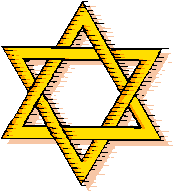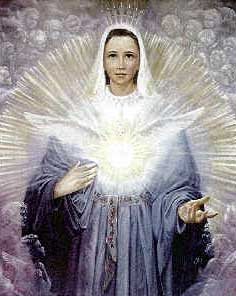|
The
White Moon Gallery presents
   by Spiralotus © All original material in this site is under copyright protection and is the intellectual property of the author. The Shekenah is the Hebrew Goddess that is invited into Jewish homes during the Sabbath. One of the first appearances of the Shekenah is in Exodus. When the Israelites set out from Succoth in their escape from Egypt the Shekenah appeared as a cloudy pillar in the day and a fiery pillar by night (Exodus 13:20). She was present at the crossing of the Red Sea and stayed with the Israelites for the forty years they were in the desert. The Goddess appears in the Zohar, Book of Splendor, and it is said that Rachel was the embodiment of the Shekenah as perceived by Jacob, who met her at the well, the same well Rebekah was told of her marriage to Isaac, Hagar was told of her son's future, and Zipporah was told of her union with Moses. The root of her name Shaken means dwelling or to abide. Her name is also associated with the word Sekeen which means knife giving some scholars reason to believe that she is associated with circumcision. The next part of her name, Ken, means Cosmic Power. She is considered the feminine element of divinity and the equivalent of Shakti for she is a life force and a catalyst of change. When the prophet Samuel annointed Saul for service to God, he was instructed to go to Rachel's tomb first. She died on a journey herself so she can guide others in honoring the natural cycles of change. The Goddess is called, "The Spring of Gardens and the Well of Living Waters". One of her symbols is the house or womb, for within her resides primal wisdom, making one of her names Sophia. Her name, Hokhma or Wisdom gives her an important role with the early Christian Gnostics as the "World Soul". It is said that King Solomon "married" her for to "set one's thoughts on Her is true Wisdom and to ever be aware of her is true Peace" (Wisdom of Solomon). The Goddess is also identified with the Holy Apple Tree. She is considered The Tree of Life. The Shekenah is the Divine's embodiment of Wisdom, Nature and Folly. She represents folly because she is influenced by her people, her worshipers, and if they do wrong, she leaves. The Shekinah resided in the Ark of the Covenant, Mount Sinai and the Mount of Olives. She appeared to Noah and Moses. It is believed that it was the Shekinah that took Moses out of the Nile, not Pharoah's daughter. The Shekenah and the Sophia are the two H's in the abbreviated name of God, YHVH. Y - is God the Father, H - God the Mother, V - is the Divine Son, H - is the Divine Daughter. In Genesis God says, "Let US make man after our own image" leading many Jewish mystics and scholars of the Kabbalah to believe that Yahweh is talking to his wife. Some researchers believe that SHE is speaking to HIM. The Hebrew word for God in Genesis is Elohim, the plural of Eloah, a feminine title for the Goddess. Eloah or Elat is the female half of El. Based on this translation, the first being created by the Divine was a physical embodiment of the Divine, not male or female, a living Yin - Yang so to speak. The lesser animals were split into male and female, not the human. This is because Adam, whose name translated from Dam and Adamah in Hebrew, means "blood" and "Earth", was a whole being. When Adam said he/she wanted a companion the female part of Adam was separated from the male. At this point male and female were still considered equals.  The union of the Divine to create a being in their own image shows us that this God is a Sexual God, leading some to believe that the Lord and Lady, channeled as one of the original forms of the Divine Masculine and Feminine would create a ceremony of Divine worship. The six sided Star of David - two triangles represents the union of the Jehova with his Shekenah and is described in the Song of Songs in the Bible. During some Jewish weddings the groom addresses his bride as, "My sister, my friend, my lover, my wife" and the bride says, "My brother, my friend, my lover, my husband". This ritual is based on Song of Songs and the meaning of YHVH as a combination of both masculine as well as feminine Divine. It is believed that during the ceremony the bride and groom are the embodiment of Jehovah and Shekenah. That is why they say when you are ill, have the bride say a prayer for your health prior to her getting married, and it will be answered. This Goddess is considered to be the tenth Sephirah and the moon. In the traditions of Judaism "blessing the moon" is a prayer of gratitude on the eve of every new moon. The Talmud says, "One who blesses the moon in the proper time is like one who is received by the Shekenah" (Sanhedrin 42a). The Aramaic translation of the Lord's Prayer by Neil Douglas-Klotz shows evidence of the Goddess in Jesus prayer, "Oh Birther, Mother-Father of the Cosmos, Hallowed be thy Name..." The Shekenah is also considered to be the Holy Spirit. Some believe that the Shekenah was the force, wind, or Breath that blew across the Isrealites to motivate them to leave Egypt. It enabled them to have the strength to leave the only home they ever knew. One of the translations of Shekenah is, "Cosmic Living Breath". The Goddess is also known as "Holy" and "All Powerful", ascending and descending, often winged, and God's "light and glory". Being winged, her other symbol, the dove, appears in Jesus baptism and to Noah in search of land. The Ruah descended on Miriam in the desert for seven days, making her a crone when she was permitted by the Divine to leave the cloud. Rabbi Shoni Labowitz believes this was so Miriam could help Moses' wife face menopause. She appears in Genesis as "the Breath of Life" that was breathed into Adam when he was created. It was the holy spirit that descended upon Mary when she was to conceive Jesus, making some believe that she was the embodiment of the Divine Mother, and suggesting that the Holy Trinity could be God the Mother (Mary or Sophia), God the Daughter (Mary Magdelene) and Goddess the Spirit Presence.
Rabbi Shoni Labowitz points out how the Asherah and the Shekenah overlap. She describes the Babylonian word for menstruation as "sabattu" which is a derivation of "sa-bat" meaning "heart rest". This was when the moon was the fullest, neither waxing nor waning. It was believed to be the time when the Goddess Asherah menstruated and is the forerunner of the Jewish Sabbath. The book of Deuteronomy 12:23 says, "the blood is the soul". In the Song of Songs or Song of Psalms, the Goddess says, "I will lead you into my mother's house, and she will teach me how to let you drink of the fragrant wine of my pomegrantate". The pomegranate representing menstruation. When Rachel took her household teraphim, which would have originally been her mother's and sat on them to hide them from her father, saying she was bleeding, she was protecting her legacy, a celebration of a bleeding goddess. Labowitz goes on to describe the importance of the Sabbath candles, passed down from mother to daughter represents the matriarchal lineage. It also helped her to understand why no matter what was left behind when a Jewish family left their home, the mother always took the Sabbath Candles. For these represent Rachel's heritage, the bleeding Goddess and the sabattu. Shoni tells us that the root letters for teraphim means to heal, make whole, restore, and cure. Rachel, the physical form of the Shekenah has come to be the guardian of women's independance and heritage.  This can be done during the full or new moon or on the traditional Jewish Sabbath, Friday 18 minutes before sundown. SUPPLIES: Two yellow or orange candles preferably the memorial candles in the thick glass, two loaves of braided Challah bread, Orange or citrus scented incense, a small bowl or glass of cloves, bay leaves, and/or cinnamon, a string or cord to make a hanger for prayer flags and five squares of different colored cloths, a paint pen or permanent marker, craft glue or a needle and thread to close the fold on the prayer flag over the cord. The altar should be facing west so while you are working you are facing in that direction and can have symbols of wisdom and wind as well as menstruation - such as an owl, a feather and a pomegranate. If you are doing this inside try to open a door or window to invite the Goddess in.
The candles can stay lit until you are going to bed then re-lit the next morning if you feel it is not safe to keep them burning during the night. Blow them out saying, "Breath of the Divine" or "Breath of God". When you re-light them in the morning say, "Light of God (Divine)". Find a nice place outside for your prayer flags and hang them up for the Sacred Ruah to take them up to heaven. If you want to dedicate a change in your life or a life of a loved one, ie: the beginning or end of menstruation, starting a new project, way of life, job, or new path, change the last part of the prayer. Instead of "Fill our Home" say, "Bless This Change In Your Holy Name". Clip Art Resources: http://clipart.christiansunite.com/ http://www.microsoft.com/ Web Resources: http://northernway.org/goddess.html http://www.amaranthine.freeserve.co.uk/pages/reviews/dashu.htm http://www.dhushara.com/book/dovcer/dov.htm http://www.jewfaq.org/prayer/shabbat.htm http://shekinah.elysiumgates.com/ http://en.wikipedia.org/wiki/Shekinah http://www.1911encyclopedia.org/S/SH/SHEKINAH.htm http://www.awakenedwoman.com/shekinah_meditation.htm http://www.ao.net/~fmoeller/shekinah.htm http://www.northernway.org/shekinah.html http://www.topical-bible-studies.org/beware/davis.htm http://www.doubter.net/id28.html http://post.queensu.ca/~jjl/jewishgoddess.htm http://members.aol.com/deswind/shekhina.html http://www.eskie.net/superior/shekinah/ Published Resources: A Woman's Journey To God by Joan Borysenko God, Sex, and The Women of the Bible by Rabbi Shoni Labowitz Herbal Rituals by Judith Berger Queen of the Sabbath Ritual and Poem by Pamela C. |
